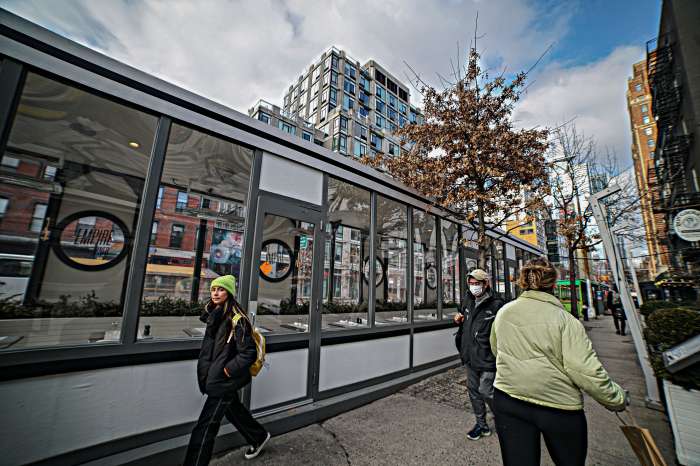Costs are increasing for restaurant owners in Flatbush due to the letter-grade inspection system now in effect in New York City for the past 19 months. This is the conclusion of a Caribbean Life survey taken last week, which also found more restauranteurs questioned were unhappy with the system than happy with it. The results are consistent with a City Council survey asking the same two questions in all boroughs.
The core issue for participants who agreed to go on the record was whether the letter-grade system actually reflected the cleanliness of the restaurant. Specifically cited were inconsistencies from inspector to inspector, cost of fines, and the feeling that small business owners are more vulnerable than corporate restaurant groups,they say.
22 independent restaurants were approached, 11 participated, 8 declined because the owner was not present, 3 owners said they were too busy to deal with the issue. Chain restaurants were excluded.
On a scale of one to five the participants were asked to rate the system:
4 of 11 rated the letter grade system a (1) poor rating. 1 gave a (2) poor-to-fair rating. 2 gave (3) fair ratings, 2 gave (4) good ratings and 2 gave (5) excellent, the highest rating.
6 of 11 said the cost of doing business has increased significantly, One said costs increased moderately, one said no not really, and three said none at all.
Of the 11 restaurants who responded, eight had A-ratings, two had B ratings and one had grade pending rating.
Citywide, 65.9 percent of A-rated restaurants gave the system a poor rating, 68 percent say the system increased their cost of doing business.
Jennifer Willis, owner of Breeze’s Jamaican Restaurant, open for five years, told Caribbean Life:
“The follow-up inspections, rather than seeing if the problems cited have been addressed, find new issues that the original inspector did not see as a problem, creating pressure from not knowing what to expect in the next inspection.”
“I know a lot of people the system has put out of business. If I knew it was so devastating i would not have started in this business, we are really, really feeling it, the stress that you know they are coming. Even if i make a profit I’m afraid to spend it because you don’t know what is coming next.”
“If I could change the system I would do an inspection every year and go back to make sure they comply.”
Winston Lewis, owner Culpepper’s Restaurant, open 12 years says:
“Its tough. But I think its a good thing. It forces you to get right and understand the codes, what they represent and mean. For example; the temperature is critical to the safety of the food.“
Culpepper’s was given a B-grade initially for minor violations, Lewis appealed, won and received an A. He says he seen new faces in his restaurant in the recent months and believes that the A-rating in his window lets passersby now that his restaurant is clean and wholesome. “The A gives you the confidence that the people behind the counter are doing what it takes.”
Still he thinks the inspectors should be more flexible when they come in late in the day, if the refrigerator is 1 or 2 degrees over in the rush hour, or sticking thermometers into the warmers in view of customers can create a bad impression. “You have a job to do but consider how your actions affect the business you are inspecting.”
Abdo Zandani owner of the Internet Coffee House which has an A-rating in the window says: “I think it is a system that truly does not reflect the true practice of the establishment. It’s more of a money maker for the city.”
One owner who did not want to give his name because his restaurant has a court date coming up, gave the process mixed reviews. He feels small restaurant owners are treated more harshly than corporate restaurants. He has spent a lot of money making changes to keep an A in his window. Other small restaurant owners have had to shut down. On the positive side, “its good for food safety, people see an A and they know its clean.”
Deborah Karim, owner of Sybil’s restaurant, which was opened 30 years ago by her mother says, “The system is not good. My restaurant is cleaner, it forces you to be cleaner, but there is no criteria, no clear-cut lines for them to cite you on. They made me dump 300 cheese rolls, then they said it was ok because the cheeses was baked.”
“On the return trip they should concern themselves with the previous citation” she says. “The first list of violations was disregarded and the follow-up was a brand new inspection”. The result being even though the problems were addressed her rating went from A to B. “My heart is going to give out because of the stress, I’ve ended up in tears. Its pitiful what they are doing to small business owners. If this continues it wont be possible to stay in business. I am not going to open again in this city.”
Mayor Bloomberg points to a Health Department statistic showing a 14 percent decrease in salmonella disease in New York City since the letter-grade system began. Another statistic shows city revenues in 2011 increased by 10 million dollars over the 2010 figure, due to increased inspections of restaurants.
Our conversation with Jennifer Willis in Breeze’s Restaurant was interrupted several times as she stopped to direct the young ladies behind the counter to get something off the floor, then to come out and wipe down the front window of the steam dishes.
If an inspector had come in, she feared those infractions may have resulted in points off or worse, a fine; and another participant said, “It takes a lot of plates at five dollars each to pay $2,800 in violation fines. I hope to be out of business before they come around again.

Photo by William Farrington
























